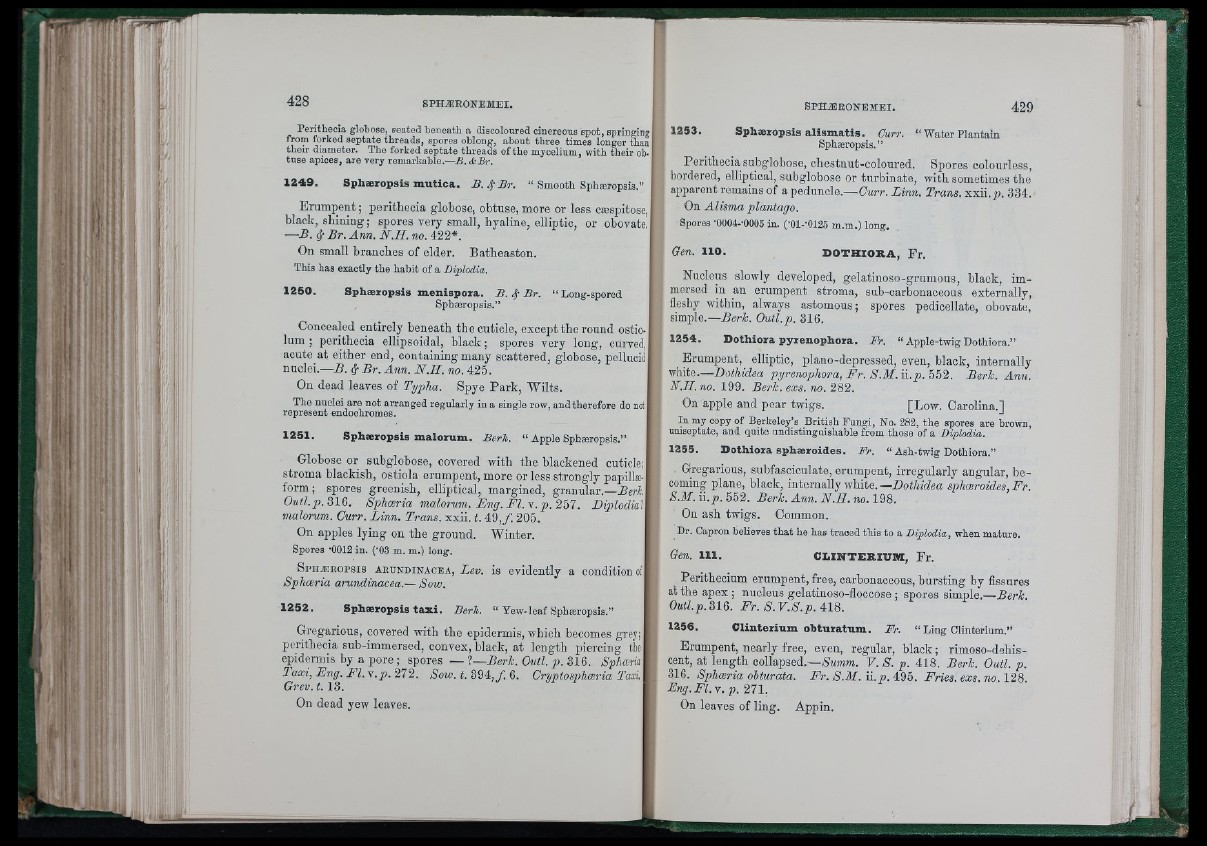
Perithecia globose, seated beneath a diseolonred cinereous spot, springing
from forked septate threads, spores oblong, about three times longer than
their diameter. The forked septate threads of the mycelium, with their obtuse
apices, are very remarkable.—B .A B r .
1 2 4 9 . Sphæropsis m u t ic a . B . 4 B r . “ Smooth Sphæropsis.”
Erumpent ; peritheoia globose, obtuse, more or less cæspitose,
black, sbining ; spores very small, byaline, elliptic, or obovate,
—B. 4 B r. Ann. N .H . no. 422*.
On small brancbes of elder. Batheaston.
This has exactly the habit of a Diplodia.
1 2 5 0 . Sphæropsis m en isp o z a . B . 4 B r. “ Long-spored
Sphæropsis.”
Concealed entirely beneatb the cuticle, except tbe round ostiolum
; perithecia ellipsoidal, black ; spores very long, curved,
acute at eitber end, containing many scattered, globose, pellucid
nuclei.—B. 4 Br. Ann. N .H . no. 425.
On dead leaves of Typha. Spye Park, Wilts.
The nuclei are not arranged regularly in a single row, and therefore do not
represent endochromes.
1 2 5 1 . Sp hæ rop sis m a lo zum . Berk. “ Apple Sphæropsis.”
Globose or subglobose, covered with the blackened cuticle;
stroma blackish, ostiola erumpent, more or less strongly papillæ-
lorm; spores greenish, elliptical, margined, granular.—Berh
Outl. p . 316. Sphoeria malorum. Eng. F I . y . p .2 5 7 . Diplodia]
malorum. Curr. Linn. Trans, xxii. t. 4 9 ,/. 205.
On apples lying on tbe ground. Winter.
Spores -0012 in. (‘03 m. m.) long.
S phæ r o p s is aeundinacea. Lev. is e v id e n tly a condition of
Sphceria arundinacea.— Sow.
1 2 5 2 . Sphæropsis t a x i . Berk. “ Yew-leaf Sphæropsis.”
Gregarious, covered witb tbe epidermis, which becomes grey;
perithecia sub-immersed, convex, black, at length piercing the
epidermis by a pore ; spores Berh. Outl. p. 316. Sphcerk
Taxi, Eng. F l. y .p . 272. Sow. t. 394, f . 6. Cryptosphceria Taxi
Orev. i. 13.
On dead yew leaves.
12 5 3 .
Perithecia subglobose, chestnut-coloured. Spores colourless,
bordered, elliptical, subglobose or turbinate, witb sometimes tbe
apparent remains of a peduncle.— Curr. Linn. Trans, xxii.y). 334.
On Alisma plantago.
Spores -0004--0005 in. (•01--0125 m.m.) long.
Gen. 1 1 0 . DOTHIORA, Pr.
Nucleus slowly developed, gelatiuoso-grumous, black, immersed
in an erumpent stroma, sub-carbonaceous externally,
fleshy within, always astomous; spores pedicellate, obovate,
simple.—Berk. Outl.p. 316.
12 5 4 . Do th io za pyz enoph o za . Fr. “ Apple-twlg Dothiora.”
Erumpent, elliptic, piano-depressed, even, black, internally
white.—Dothidea pyrenophora, F r . S.M. ii.p. 552. Berk. Ann.
N.H. no. 199. Berk. exs. no. 282.
On apple and pear twigs. [Low. Carolina.]
In my copy of Berkeley’s British Fungi, No. 282, the spores are brown,
nniseptate, and quite nndistiugaishable from those of a Diplodia.
1255. Do th io za sphsezoides. Fr. “ Ash-twig Dothiora.”
Gregarious, subfasciculate, erumpent, irregularly angular, becoming
plane, black, internally white. —Dothidea sphceroides, Fr.
S.M. ii.)). 552. Berk. Ann. N .H . no. 198.
On asb twigs. Common.
Dr. Capron believes that he has traced this to a Diplodia, when mature.
Gen. 111. CLINTERITJIffl, Pr.
Perithecium erumpent, free, carbonaceous, bursting by fissures
at tbe apex ; nucleus gelatinoso-floooose ; spores simple.—Berk
Outl.p. 316. Fr. S. V .S .p . 418.
1256. C lin te z ium o b tu za tum . Fr. “ Ling Clinterium.”
Erumpent, nearly free, even, regular, black ; rimoso-dehis-
cent, a tle n g th collapsed.—Summ. V .S . p. 418. Berk. Outl. p.
316. Sphceria ohturata. Fr. S .M . ii.p. 495. Fries, exs. no. 128.
En g .F l.y. p. 271.
On leaves of ling. Appin.